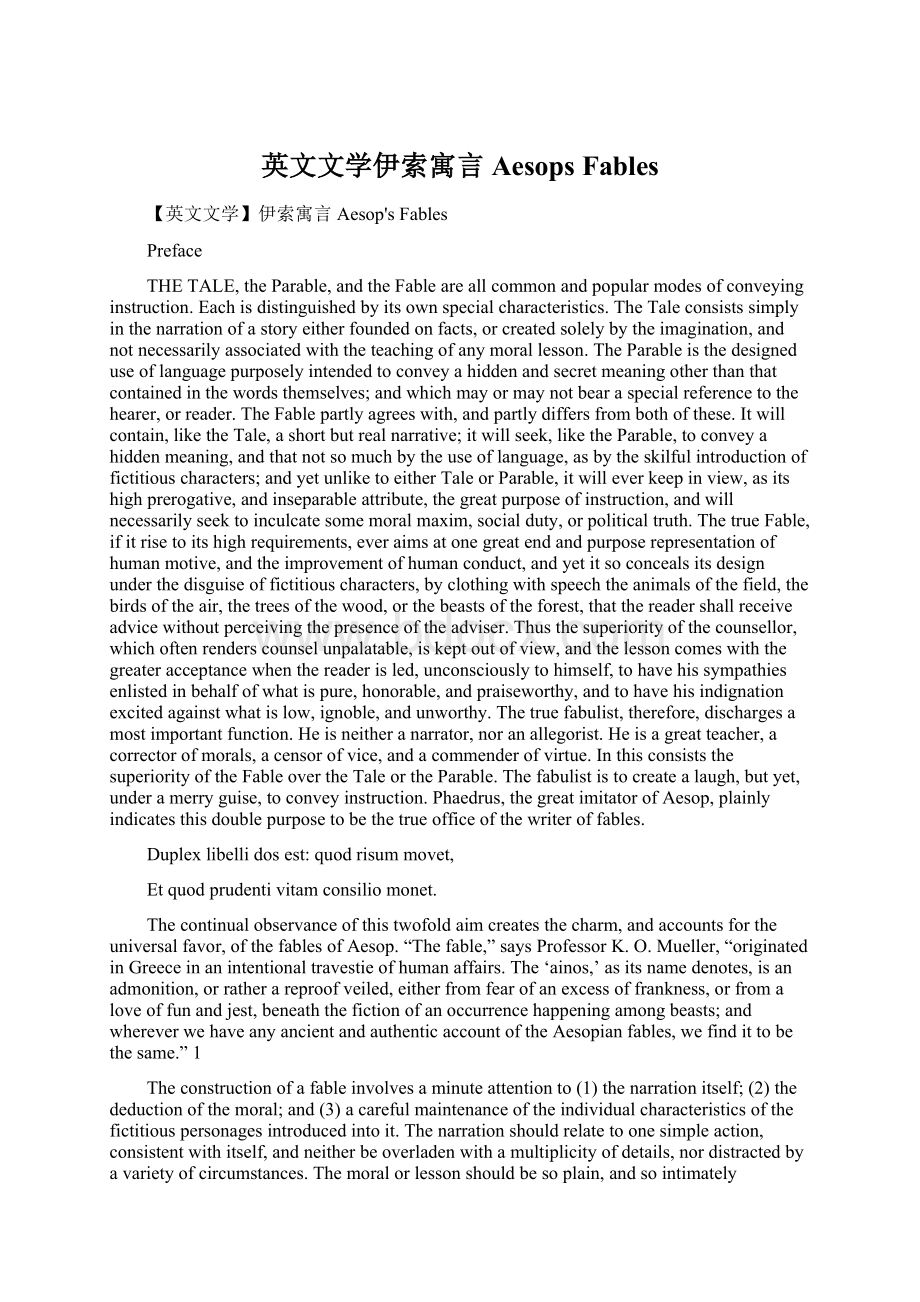英文文学伊索寓言 Aesops FablesWord文档格式.docx
《英文文学伊索寓言 Aesops FablesWord文档格式.docx》由会员分享,可在线阅读,更多相关《英文文学伊索寓言 Aesops FablesWord文档格式.docx(68页珍藏版)》请在冰豆网上搜索。

sFables
Preface
THETALE,theParable,andtheFableareallcommonandpopularmodesofconveyinginstruction.Eachisdistinguishedbyitsownspecialcharacteristics.TheTaleconsistssimplyinthenarrationofastoryeitherfoundedonfacts,orcreatedsolelybytheimagination,andnotnecessarilyassociatedwiththeteachingofanymorallesson.TheParableisthedesigneduseoflanguagepurposelyintendedtoconveyahiddenandsecretmeaningotherthanthatcontainedinthewordsthemselves;
andwhichmayormaynotbearaspecialreferencetothehearer,orreader.TheFablepartlyagreeswith,andpartlydiffersfrombothofthese.Itwillcontain,liketheTale,ashortbutrealnarrative;
itwillseek,liketheParable,toconveyahiddenmeaning,andthatnotsomuchbytheuseoflanguage,asbytheskilfulintroductionoffictitiouscharacters;
andyetunliketoeitherTaleorParable,itwilleverkeepinview,asitshighprerogative,andinseparableattribute,thegreatpurposeofinstruction,andwillnecessarilyseektoinculcatesomemoralmaxim,socialduty,orpoliticaltruth.ThetrueFable,ifitrisetoitshighrequirements,everaimsatonegreatendandpurposerepresentationofhumanmotive,andtheimprovementofhumanconduct,andyetitsoconcealsitsdesignunderthedisguiseoffictitiouscharacters,byclothingwithspeechtheanimalsofthefield,thebirdsoftheair,thetreesofthewood,orthebeastsoftheforest,thatthereadershallreceiveadvicewithoutperceivingthepresenceoftheadviser.Thusthesuperiorityofthecounsellor,whichoftenrenderscounselunpalatable,iskeptoutofview,andthelessoncomeswiththegreateracceptancewhenthereaderisled,unconsciouslytohimself,tohavehissympathiesenlistedinbehalfofwhatispure,honorable,andpraiseworthy,andtohavehisindignationexcitedagainstwhatislow,ignoble,andunworthy.Thetruefabulist,therefore,dischargesamostimportantfunction.Heisneitheranarrator,noranallegorist.Heisagreatteacher,acorrectorofmorals,acensorofvice,andacommenderofvirtue.InthisconsiststhesuperiorityoftheFableovertheTaleortheParable.Thefabulististocreatealaugh,butyet,underamerryguise,toconveyinstruction.Phaedrus,thegreatimitatorofAesop,plainlyindicatesthisdoublepurposetobethetrueofficeofthewriteroffables.
Duplexlibellidosest:
quodrisummovet,
Etquodprudentivitamconsiliomonet.
Thecontinualobservanceofthistwofoldaimcreatesthecharm,andaccountsfortheuniversalfavor,ofthefablesofAesop.“Thefable,”saysProfessorK.O.Mueller,“originatedinGreeceinanintentionaltravestieofhumanaffairs.The‘ainos,’asitsnamedenotes,isanadmonition,orratherareproofveiled,eitherfromfearofanexcessoffrankness,orfromaloveoffunandjest,beneaththefictionofanoccurrencehappeningamongbeasts;
andwhereverwehaveanyancientandauthenticaccountoftheAesopianfables,wefindittobethesame.”1
Theconstructionofafableinvolvesaminuteattentionto
(1)thenarrationitself;
(2)thedeductionofthemoral;
and(3)acarefulmaintenanceoftheindividualcharacteristicsofthefictitiouspersonagesintroducedintoit.Thenarrationshouldrelatetoonesimpleaction,consistentwithitself,andneitherbeoverladenwithamultiplicityofdetails,nordistractedbyavarietyofcircumstances.Themoralorlessonshouldbesoplain,andsointimatelyinterwovenwith,andsonecessarilydependenton,thenarration,thateveryreadershouldbecompelledtogivetoitthesameundeniableinterpretation.Theintroductionoftheanimalsorfictitiouscharactersshouldbemarkedwithanunexceptionablecareandattentiontotheirnaturalattributes,andtothequalitiesattributedtothembyuniversalpopularconsent.TheFoxshouldbealwayscunning,theHaretimid,theLionbold,theWolfcruel,theBullstrong,theHorseproud,andtheAsspatient.Manyofthesefablesarecharacterizedbythestrictestobservanceoftheserules.Theyareoccupiedwithoneshortnarrative,fromwhichthemoralnaturallyflows,andwithwhichitisintimatelyassociated.“’Tisthesimplemanner,”saysDodsley,2“inwhichthemoralsofAesopareinterwovenwithhisfablesthatdistinguisheshim,andgiveshimthepreferenceoverallothermythologists.His‘MountaindeliveredofaMouse,’producesthemoralofhisfableinridiculeofpompouspretenders;
andhisCrow,whenshedropshercheese,letsfall,asitwerebyaccident,thestrongestadmonitionagainstthepowerofflattery.Thereisnoneedofaseparatesentencetoexplainit;
nopossibilityofimpressingitdeeper,bythatloadwetoooftenseeofaccumulatedreflections.”3Anequalamountofpraiseisduefortheconsistencywithwhichthecharactersoftheanimals,fictitiouslyintroduced,aremarked.Whiletheyaremadetodepictthemotivesandpassionsofmen,theyretain,inaneminentdegree,theirownspecialfeaturesofcraftorcounsel,ofcowardiceorcourage,ofgenerosityorrapacity.
Thesetermsofpraise,itmustbeconfessed,cannotbebestowedonallthefablesinthiscollection.Manyofthemlackthatunityofdesign,thatcloseconnectionofthemoralwiththenarrative,thatwisechoiceintheintroductionoftheanimals,whichconstitutethecharmandexcellencyoftrueAesopianfable.Thisinferiorityofsometoothersissufficientlyaccountedforinthehistoryoftheoriginanddescentofthesefables.ThegreatbulkofthemarenottheimmediateworkofAesop.Manyareobtainedfromancientauthorspriortothetimeinwhichhelived.Thus,thefableofthe“HawkandtheNightingale”isrelatedbyHesiod;
4the“EaglewoundedbyanArrow,wingedwithitsownFeathers,”byAeschylus;
5the“FoxavenginghiswrongsontheEagle,”byArchilochus.6Manyofthemagainareoflaterorigin,andaretobetracedtothemonksofthemiddleages:
andyetthiscollection,thoughthusmadeupoffablesbothearlierandlaterthantheeraofAesop,rightfullybearshisname,becausehecomposedsolargeanumber(allframedinthesamemould,andconformedtothesamefashion,andstampedwiththesamelineaments,image,andsuperscription)astosecuretohimselftherighttobeconsideredthefatherofGreekfables,andthefounderofthisclassofwriting,whichhaseversincebornehisname,andhassecuredforhim,throughallsucceedingages,thepositionofthefirstofmoralists.7
ThefableswereinthefirstinstanceonlynarratedbyAesop,andforalongtimewerehandeddownbytheuncertainchanneloforaltradition.SocratesismentionedbyPlato8ashavingemployedhistimewhileinprison,awaitingthereturnofthesacredshipfromDelphoswhichwastobethesignalofhisdeath,inturningsomeofthesefablesintoverse,buthethusversifiedonlysuchasheremembered.DemetriusPhalereus,aphilosopheratAthensabout300B.C.,issaidtohavemadethefirstcollectionofthesefables.Phaedrus,aslavebybirthorbysubsequentmisfortunes,andadmittedbyAugustustothehonorsofafreedman,imitatedmanyofthesefablesinLatiniambicsaboutthecommencementoftheChristianera.Aphthonius,arhetoricianofAntioch,A.D.315,wroteatreatiseon,andconvertedintoLatinprose,someofthesefables.Thistranslationisthemoreworthyofnotice,asitillustratesacustomofcommonuse,bothintheseandinlatertimes.TherhetoriciansandphilosopherswereaccustomedtogivetheFablesofAesopasanexercisetotheirscholars,notonlyinvitingthemtodiscussthemoralofthetale,butalsotopracticeandtoperfectthemselvestherebyinstyleandrulesofgrammar,bymakingforthemselvesnewandvariousversionsofthefables.Ausonius,9thefriendoftheEmperorValentinian,andthelatestpoetofeminenceintheWesternEmpire,hashandeddownsomeofthesefablesinverse,whichJulianusTitianus,acontemporarywriterofnogreatname,translatedintoprose.Avienus,alsoacontemporaryofAusonius,putsomeofthesefablesintoLatinelegiacs,whicharegivenbyNevelet(inabookweshallrefertohereafter),andareoccasionallyincorporatedwiththeeditionsofPhaedrus.
SevencenturieselapsedbeforethenextnoticeisfoundoftheFablesofAesop.Duringthislongperiodthesefablesseemtohavesufferedaneclipse,tohavedisappearedandtohavebeenforgotten;
anditisatthecommencementofthefourteenthcentury,whentheByzantineemperorswerethegreatpatronsoflearning,andamidstthesplendorsofanAsiaticcourt,thatwenextfindhonorspaidtothenameandmemoryofAesop.MaximusPlanudes,alearnedmonkofConstantinople,madeacollectionofaboutahundredandfiftyofthesefables.Littleisknownofhishistory.Planudes,however,wasnomererecluse,shutupinhismonastery.Hetookanactivepartinpublicaffairs.In1327A.D.hewassentonadiplomaticmissiontoVenicebytheEmperorAndronicustheElder.ThisbroughthimintoimmediatecontactwiththeWesternPatriarch,whoseinterestshehenceforthadvocatedwithsomuchzealastobringonhimsuspicionandpersecutionfromtherulersoftheEasternChurch.Planudeshasbeenexposedtoatwo-foldaccusation.HeischargedontheonehandwithhavinghadbeforehimacopyofBabrias(towhomweshallhaveoccasiontoreferatgreaterlengthintheendofthisPreface),andtohavehadthebadtaste“totranspose,”ortoturnhispoeticalversionintoprose:
andheisasserted,ontheotherhand,nevertohaveseentheFablesofAesopatall,buttohavehimselfinventedandmadethefableswhichhepalmedoffunderthenameofthefamousGreekfabulist.Thetruthliesbetweenthesetwoextremes.Planudesmayhaveinventedsomefewfables,orhaveinse